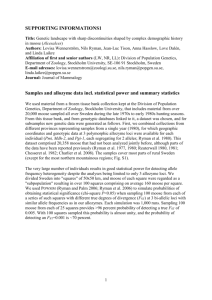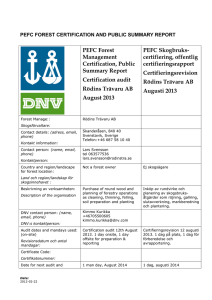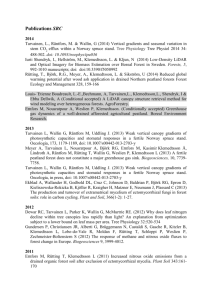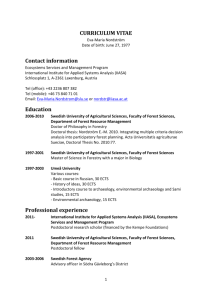Grimsö - SITES
advertisement
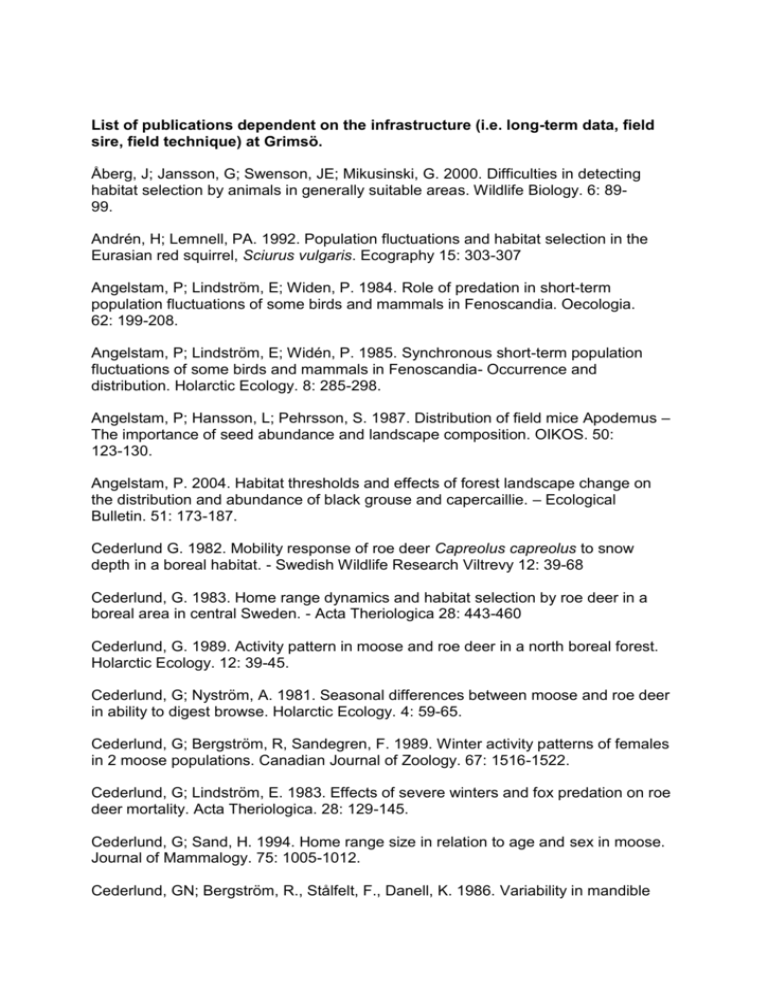
List of publications dependent on the infrastructure (i.e. long-term data, field sire, field technique) at Grimsö. Åberg, J; Jansson, G; Swenson, JE; Mikusinski, G. 2000. Difficulties in detecting habitat selection by animals in generally suitable areas. Wildlife Biology. 6: 8999. Andrén, H; Lemnell, PA. 1992. Population fluctuations and habitat selection in the Eurasian red squirrel, Sciurus vulgaris. Ecography 15: 303-307 Angelstam, P; Lindström, E; Widen, P. 1984. Role of predation in short-term population fluctuations of some birds and mammals in Fenoscandia. Oecologia. 62: 199-208. Angelstam, P; Lindström, E; Widén, P. 1985. Synchronous short-term population fluctuations of some birds and mammals in Fenoscandia- Occurrence and distribution. Holarctic Ecology. 8: 285-298. Angelstam, P; Hansson, L; Pehrsson, S. 1987. Distribution of field mice Apodemus – The importance of seed abundance and landscape composition. OIKOS. 50: 123-130. Angelstam, P. 2004. Habitat thresholds and effects of forest landscape change on the distribution and abundance of black grouse and capercaillie. – Ecological Bulletin. 51: 173-187. Cederlund G. 1982. Mobility response of roe deer Capreolus capreolus to snow depth in a boreal habitat. - Swedish Wildlife Research Viltrevy 12: 39-68 Cederlund, G. 1983. Home range dynamics and habitat selection by roe deer in a boreal area in central Sweden. - Acta Theriologica 28: 443-460 Cederlund, G. 1989. Activity pattern in moose and roe deer in a north boreal forest. Holarctic Ecology. 12: 39-45. Cederlund, G; Nyström, A. 1981. Seasonal differences between moose and roe deer in ability to digest browse. Holarctic Ecology. 4: 59-65. Cederlund, G; Bergström, R, Sandegren, F. 1989. Winter activity patterns of females in 2 moose populations. Canadian Journal of Zoology. 67: 1516-1522. Cederlund, G; Lindström, E. 1983. Effects of severe winters and fox predation on roe deer mortality. Acta Theriologica. 28: 129-145. Cederlund, G; Sand, H. 1994. Home range size in relation to age and sex in moose. Journal of Mammalogy. 75: 1005-1012. Cederlund, GN; Bergström, R., Stålfelt, F., Danell, K. 1986. Variability in mandible marrow fat in 3 moose populations in Sweden. Journal of Wildlife Management. 50: 719-726. Cederlund, GN; Bergström, R., Danell, K. 1989. Seasonal variation in mandible marrow fat in moose. Journal of Wildlife Management. 53: 587-592. Cederlund, GN; Okarma, H. 1988. Home range and habitat use of adult female moose. Journal of Wildlife Management. 52: 336-343. Cederlund, GN; Sand, HKG. 1991. Population dynamics and yield of a moose population without predators. Alces. 27: 31-40. Cederlund, GN; Sand, HKG. 1992. Dispersal of subadult moose (Alces alces) in a nonmigratory population. Canadian Journal of Zoology. 70: 1309-1314. Cederlund, GN; Sand, HKG; Pehrson, Å. 1991. Body mass dynamics of moose calves in relation to winter severeity. Journal of Wildlife Management. 55: 675681. Cederlund, G; Kjellander, P; Liberg, O. 1993. Effects of buck hunting on spatial distribution among roe deer Capreolus capreolus L. Proceedings of the International Union of Game Biologists Congress. 21: 271-278. Cederlund G; Ljungqvist, H., Markgren, G., Stålfelt, F. 1980. Foods of moose Alces alces and roe deer Capreolus capreolus at Grimsö in central Sweden. Results f rumen content analyses. Swedish Wildlife Research Viltrevy. 11: 169-247. Faber, WE; Pehrson, Å; Jordan, PA. 1993. Seasonal use of salt blocks by mountain hares in Sweden. Journal of Wildlife Management. 57: 842-846. Faber, WE; Pehrson, Å; Jordan, PA. 1995. Effect of substrate drying method on invitro dry-matter disappearance in moose. Journal of range management. 48: 557-559. Faber, WE; Thorson, EM. 1996. Bark stripping of young Pinus sylvestris by Alces alces on the individual, stand, and landscape level in Sweden. Canadian Journal of Forest Research. 26: 2109-2114. Hake, M; Kjellen, N; Alerstam, T. 2001. Satellite tracking of Swedish Ospreys Pandion haliaetus: Autumn migration routes and orientation. Journal of Avian Biology. 32: 47-56. Helldin, J-O.; Danielsson, Anna V. 2007. Changes in red fox Vulpes vulpes diet due to colonisation by lynx Lynx lynx. Wildlife Biology. 13: 475-480. Helldin, JO. 1999. Diet, body condition, and reproduction of Eurasian pine martens Martes martes during cycles in microtine density. – Ecography. 22: 324-336. Helldin, J. O.; Liberg, O.; Gloersen, G. 2006. Lynx (Lynx lynx) killing red foxes (Vulpes vulpes) in boreal Sweden - frequency and population effects. Journal of Zoology. 270: 657-663. Hobbs, N.T., Andrén, H., Persson, J., Aronsson, M. and Chapron, G. 2012. Native predators reduce harvest of reindeer by Sámi pastoralists. Ecological Applications. 22: 1640-1654 Karlsson, J; Johansson, Ö. 2010.Predictability of repeated carnivore attacks on livestock favours reactive use of mitigation measures. Journal of Applied Ecology. 47: 166-171. Kjellander, P; Nordström, J. 2003. Cyclic voles, prey switching in red fox, and roe deer dynamics - a test of the alternative prey hypothesis. OIKOS. 101: 338-344. Kjellen, N; Hake, M; Alerstam, T. 2001. Tinting and speed of migration in male, female and juvenile Ospreys Pandion haliaetus between Sweden and Africa as revealed by field observations, radar and satellite tracking. Journal of Avian Biology. 32: 57-67. Lemnell PA; Lindelöf B. 1982. Experimental release of captive reared mountain hares Lepus timidus. Swedish Wildlife Research Viltrevy. 12: 115-128. Lindlöf, B; Pehrson, Å; Johansson, A. 1978. Summer food preference by penned mountain hares in relation to nutrient content. Journal of Wildlife Management. 42: 928-932. Liberg, O; Andrén, H; Pedersen, HC; Sand, H; Sejberg, D; Wabakken, P; Åkesson, M; Bensch, S. 2005. Severe inbreeding depression in a wild wolf (Canis lupus) population. Biology Letters. 1: 17-20. Liberg, O; Chapron, G; Wabakken, P; Pedersen, HC; Hobbs, NT; Sand, H. 2012. Shoot, shovel and shut up: cryptic poaching slows restoration of a large carnivore in Europe. Proceedings of the Royal Society B-Biological Sciences. 279: 910-915. Lindström, E. 1981. Reliability of placental scar counts in the red fox (Vulpes vulpes) with special reference to fading of the scar. Mammal Review. 11: 137-149. Lindström, E. 1983. Condition and growth of red foxes (Vulpes vulpes) in relation to food supply. Journal of Zoology. 199: 117- 122. Lindström, E. 1988. Reproductive effort in the red fox Vulpes vulpes and future supply of a fluctuating prey. OIKOS. 52: 115-119. Lindström, E. 1989. Food limitation and social regulation in a red fox population. Holarctic Ecology. 12: 70-79. Lindström, E; Andrén, H; Angelstam, P; Widen, P. 1986. Influence of predators on hare populations in Sweden - a critical review. Mammal Review. 16:151-156. Lindström, ER. 1994. Large prey for small cubs - on crucial resources of a boreal red fox population. Ecography. 17: 17-22. Lindström, ER. 1994. Placental scar counts in the red fox (Vulpes vulpes L.) revisited. Zeitschrift für Saugetierkunde-International Journal of Mammalian Biology. 59: 169-173. Lindström, ER; Andrén, H; Angelstam, P; Cederlund, G; Hörnfeldt, B; Jäderberg, L; Lemnell, PA; Martinsson, B; Sköld, K; Swenson, JE. 1994. Disease reveals the predator – Sarcoptic mange, red fox predation and prey populations. Ecology. 75: 1042-1049. Lindström, ER; Hörnfeldt, B. 1994. Vole cycles, snow depth and fox predation. OIKOS. 70: 156-160. Månsson, J. 2009. Environmental variation and moose Alces alces density as determinants of spatio-temporal heterogeneity in browsing. Ecography. 32: 601612. Månsson, J; Andrén, H; Pehrson, Å; Bergström, R. 2007. Moose browsing and forage availability: a scale-dependent relationship? Canadian Journal of Zoology. 85: 372-380. Månsson, J; Andrén, H; Sand, H. 2011. Can pellet counts be used to accurately describe winter habitat selection by moose Alces alces? European Journal of Wildlife Research. 57: 1017-1023. Månsson, J; Hauser, C E.; Andrén, H; Possingham, H P. 2011. Survey method choice for wildlife management: the case of moose Alces alces in Sweden. – Wildlife Biology. 17: 176-190. Månsson, J; Kalen, C; Kjellander, P; Andrén, H; Smith, H. 2007. Quantitative estimates of tree species selectivity by moose (Alces alces) in a forest landscape. Scandinavian Journal of Forest Research. 22:407-414. Månsson, J., Bunnefeld, N., Andrén, H. and Ericsson, G. 2012. Spatial and temporal predictions of moose winter distribution. .Oecologia. In press. Nordström, J; Kjellander, P; Andrén, H; Mysterud, A. 2009. Can supplemental feeding of red foxes Vulpes vulpes increase roe deer Capreolus capreolus recruitment in the boreal forest? Wildlife Biology 15: 222-227. Nyström, A. 1980. Selection and consumption of winter browse by moose calves. Journal of Wildlife Management. 44: 463-468. Pehrson, Å. 1983. Digestibility and retention of food components in caged mountain hares Lepus timidus during the winter. Holarctic Ecology. 6: 395-403. Pehrson, Å; Faber, WE. 1994. Individual variation of in-vitro dry matter digestibility in moose. Journal of Range Management. 47: 392-394. Pehrson, Å; Lindelöf, B. 1984. Impact of winter nutrition on reproduction in captive mountain hares (Lepus timidus, Mammalia, Lagomorpha). Journal of Zoology. 204: 201-209. Pehrson, Å; Palo, RT; Staaland, H; Jordan, PA. 1997. Seasonal variation in weight of junctional segments of the gastrointestinal tract and its contents in young moose (Alces alces). ALCES. 33: 1-10. Pehrson, Å. 1984. Fecal nitrogen as an index of hare browse quality. Canadian Journal of Zoology. 62: 510-513. Rönnegård, L., Sand, H., Andrén, H., Månsson, J. and Pehrson, Å. 2008. Evaluation of four methods used to estimate population density of moose Alces alces. Wildlife Biology. 14: 358-371. Sand, H. 1998. Costs of reproduction in female moose (Alces alces) as measured by means of phenotypic correlations. Canadian Journal of Zoology. 76: 187-193. Sand, H; Cederlund, G. 1996. Individual and geographical variation in age at maturity in female moose (Alces alces). Canadian Journal of Zoology. 74: 954-964. Sand, H.; Wikenros, C.; Ahlqvist, P.; Stromseth, T. H.; Wabakken, P. 2012. Comparing body condition of moose (Alces alces) selected by wolves (Canis lupus) and human hunters: consequences for the extent of compensatory modality. Canadian Journal of Zoology. 90: 403-412. Sand, H; Bergstrom, R; Cederlund, G; Ostergren, M; Stålfelt, F. 1996. Density dependent variation in reproduction and body mass in female moose Alces alces. Wildlife Biology. 2: 233-245. Staaland, H; Pehrson, Å; Jordan, P; Palo, RT. 1992. Seasonal variation of alimentary mineral and nitrogen pools on the moose. Comparative Biochemistry and Physiology A-Physiology.102: 163-171. Storch, I; Lindström, E; DeJounge, J. 1990. Diet and habitat selection of the pine marten in relation to competition with red fox. Acta Theriologica. 35: 311-320. Swenson, JE. 1991. Evaluation of a density index for territorial male hazel grouse Bonasa bonasia in spring and autumn. Ornis Fennica. 68: 57-65. Swenson, JE. 1992. Determination of the relative age of adult hazel grouse. Journal für Ornithologie. 133: 209-212. Swenson, JE; Angelstam, P. 1993. Habitat separation by sympatric forest grouse in Fennoscandia in relation to boreal forest succession. Canadian Journal of Zoology. 71: 1303-1310. Swenson, JE. 1993. Hazel grouse (Bonasa bonasia) pairs during the nonbreeding season - mutual benefits of a cooperative alliance. Behavioral Ecology. 4: 1421. Thorup, K; Alerstam, T; Hake, M; Kjellen, N. 2006. Traveling or stopping of migrating birds in relation to wind: an illustration for the osprey. Behavioral Ecology. 17: 497-502. Widen, P; Andrén, H; Angelstam, P; Lindström, E. 1987. The effect of prey vulnerability - goshawk predation and population fluctuations of small game. OIKOS 49: 233-235. Widen P. 1984. Activity patterns and time-budget in the goshawk Accipiter gentilis in a boreal forest area in Sweden. Ornis Fennica. 61: 109-112. Widen, P. 1987. Goshawk predation during winter, spring and summer in a boreal forest area of central Sweden. Holarctic Ecology. 10: 104-109. Widen, P. 1989. The hunting habitats of goshawk Accipiter gentilis in boreal forest of central Sweden. IBIS. 131: 205-231. List of publications that are partly related to the infrastructure at Grimsö. Åberg J; Jansson, G; Swenson, JE; Angelstam, P. 1995. The effect of matrix on the occurrence of hazel grouse (Bonasa bonasia) in isolated habitat fragments. Oecologia. 103: 265-269. Åberg, J; Swenson, JE; Andrén, H. 2000. The dynamics of hazel grouse (Bonasa bonasia L.) occurrence in habitat fragments. Canadian Journal of Zoology. 78: 352-358. Åberg, J; Swenson, JE; Angelstam, P. 2003. The habitat requirements of hazel grouse (Bonasa bonasia) in managed boreal forest and applicability of forest stand descriptions as a tool to identify suitable patches. Forest Ecology and Managment. 175: 437-444. Andrén, H. 1990. Despotic distribution, unequal reproductive success and population regulation in the jay Garrulus glandarius L. Ecology. 71:1796-1803. Andrén, H; Angelstam, P. 1988. Elevated predation rates as an edge effect in habitat islands: experimental evidence. Ecology. 69: 544-547. Andrén, H. 1992. Corvid density and nest predation in relation to forest fragmentation: A landscape perspective. Ecology. 73: 794-804. Andrén, H; Angelstam, P. 1993. Moose browsing on Scots pine in relation to stand size and distance to forest edge. Journal of Applied Ecology. 30: 133-142. Andrén, H; Delin, A. 1994. Habitat selection in the Eurasian red squirrel Sciurus vulgaris in relation to forest fragmentation. - OIKOS 70: 43-48 Angelstam, P. 1984. Sexual and seasonal differences in mortality of the black grouse Tetrao tetrix in boreal Sweden. Ornis Scandinavia. 15: 123-134. Angelstam, P. 1986. Predation on ground-nesting birds nests in relation to predator densities and habitat edge. OIKOS 47: 365-373. Angelstam, P; Wikberg, P-E; Danilov, P; Faber, WE.; Nygren, K. 2000. Effects of moose density on timber quality and biodiversity restoration in Sweden, Finland, and Russian Karelia. Alces. 36: 133-145. Bensch, S; Andrén, H; Hansson, B; Pedersen, H C; Sand, H; Sejberg, D; Wabakken, P; Åkesson, M; Liberg, O. 2006. Selection for Heterozygosity Gives Hope to a Wild Population of Inbred Wolves. -PLOS ONE. 1: e72. Brainerd, SM; Helldin, JO; Lindström, ER; Rolstad, E; Rolstad, J; Storch, I. 1995. Pine marten (Martes martes) selection of resting and denning sites in Scandinavian managed forests. Annales Zoologici Fennici. 32: 151-157. Brainerd, SM; Rolstad, J. 2002. Habitat selection by Eurasian pine martens Martes martes in managed forests of southern boreal Scandinavia. Wildlife Biology. 8. 289-297. Delin, AE; Andrén, H. 1999. Effects of habitat fragmentation on Eurasian red squirrel (Sciurus vulgaris) in a forest landscape. Landscape Ecology. 14: 67-72. Diaz, R; Steen, M; Faber, WE. 1996. Studies of a disease with ulcerative and necrotizing lesions in Swedish roe deer (Capreolus capreolus). Journal of Zoo and Wildlife Medicine. 27: 71-75. Faber, WE. 1996. Bark stripping by moose on young Pinus sylvestris in south-central Sweden. - Scandinavian Journal of Forest Research. 11: 300-306. Faber, WE; Lavsund, S. 1999. Summer foraging on Scots pine Pinus sylvestris by moose Alces alces in Sweden - patterns and mechanisms. Wildlife Biology. 5: 93-106. Hake, M; Kjellen, N; Alerstam, T. 2003. Age-dependent migration strategy in honey buzzards Pernis apivorus tracked by satellite. OIKOS. 103: 385-396. Helldin, J.O.; Lindström, ER. 1993. Dietary and numerical responses of pine marten (Martes martes) to vole cycles in boreal Fennoscandia. Proceedings of the International Union of Game Biologists Congress. 21: 220-224. Helldin, JO. 1997. Age determination of Eurasian pine martens by radiographs of teeth in situ. Wildlife Society Bullentin. 25: 83-88. Helldin, JO. 2000. Seasonal diet of pine marten Martes martes in southern boreal Sweden. Acta Theriologica. 45: 409-420. Helldin, JO. 2000. Population trends and harvest management of pine marten Martes martes in Scandinavia. Wildlife Biology. 6: 111-120. Helldin, JO; Lindström, ER. 1995. Late winter social activity in pine marten (Martes martes) - false heat or dispersal. Annales Zoologici Fennici. 32: 145-149. Jansson, G. 2002. Scaling and habitat proportions in relation to bird diversity in managed boreal forests. Forest Ecology and Managment. 157: 77-86. Jansson, G; Andrén, H. 2003. Habitat composition and bird diversity in managed boreal forests. Scandinavian Journal of Forest Research. 18: 225-236. Jansson, G; Angelstam, P. 1999. Threshold levels of habitat composition for the presence of the long-tailed tit (Aegithalos caudatus) in a boreal landscape. Landscape Ecology. 14:283-290. Jansson, G; Pehrson, Å. 2007. The recent expansion of the brown hare (Lepus europaeus) in Sweden with possible implications to the mountain hare (Ltimidus). European Journal of Wildlife Research. 53: 125-130. Jansson, G; Thulin, C-G; Pehrson, Å. 2007. Factors related to the occurrence of hybrids between brown hares Lepus europaeus and mountain hares L. timidus in Sweden. Ecography. 30: 709-715. Lindström, E; Mörner, T. 1985. The spreading of sarcoptic mange among Swedish red fox (Vulpes vulpes L) in relation to fox population dynamics. Revue d Ecologie - la Terre et la Vie. 40: 211-216. Lindström, ER; Brainerd, SM, Helldin, JO, Overskaug, K. 1995. Pine marten red fox interactions - a case of intraguild predation. Annales Zoologici Fennici. 32: 123130. Mikusinski, G. 1995. Population trends in black woodpecker in relation to changes and characteristics of European forests. Ecography. 18: 363-369. Mikusinski, G. 1997. Winter foraging of the black woodpecker Dryocopus martius in managed forest in south-central Sweden. Ornis Fennica. 74: 161-166. Rodriguez, A; Andrén, H. 1999. A comparison of Eurasian red squirrel distribution in different fragmented landscapes. Journal of Applied Ecology. 36: 649-662. Rodriguez, A; Andrén, H; Jansson, G. 2001. Habitat-mediated predation risk and decision making of small birds at forest edges. OIKOS. 95: 383-396. Rodriguez, A; Jansson, G; Andrén, H. 2007. Composition of an avian guild in spatially structured habitats supports a competition-colonization trade-off. Proceedings of the Royal Society B-Biological Sciences. 274: 1403-1411. Sand, H. 1996. Life history patterns in female moose (Alces alces): The relationship between age, body size, fecundity and environmental conditions. Oecologia. 106: 212-220. Sand, H; Cederlund, G; Danell, K. 1995. Geographical and latitudinal variation in growth patterns and adult body size of Swedish moose (Alces alces). Oecologia. 102: 433-442. Seiler, A; Lindström, E; Stenström, D. 1995. Badger abundance and activity in relation to fragmentation of foraging biotopes. Annales Zoologici Fennici. 32: 37-45. Strandberg, R; Alerstam, T; Hake, M; Kjellen, N. 2009. Short-distance migration of the Common Buzzard Buteo buteo recorded by satellite tracking. IBIS. 151: 200-206. Swenson, JE. 1993. The important of alder to hazel grouse in Fennoscandian boreal forest - evidence from 4 levels of scale. Ecography. 16: 37-46. Thorup, K; Alerstam, T; Hake, M; Kjellen, N. 2003. Bird orientation: compensation for wind drift in migrating raptors is age dependent. Proceedings of the Royal Society B-Biological Sciences. 270: 8-11. Thorup, K; Fuller, M; Alerstam, T; Hake, M; Kjellen, N; Strandberg, R. 2006. Do migratory flight paths of raptors follow constant geographical or geomagnetic courses? Animal Behaviour 72: 875-880. Uliczka, H; Angelstam, P. 1999. Occurrence of epiphytic macrolichens in relation to tree species and age in managed boreal forest. Ecography. 22: 396-405. Uliczka, H; Angelstam, P. 2000. Assessing conservation values of forest stands based on specialised lichens and birds. Biological Conservation. 95: 343-351. Wikenros, C; Liberg, O; Sand, H; Andrén, H. 2010. Competition between recolonizing wolves and resident lynx in Sweden. Canadian Journal of Zoology. 88: 271-279. Selection of reports that have included some long-term data sets from Grimsö. Cederlund G. m.fl. 1979. Radio tracking techniques and the reliability of systems used for larger birds and mammals. The Swedish Environmental Protection Board/SNV PM 1136. Cederlund G. m.fl. 1981. Orienteringstävlingars inverkan på älg och rådjur. SNV PM 1418. Helldin, J.-O. 2004. Lodjurspredation på räv – och dess sekundära effekter på bytespopulationerna- Slutrapport, Grimsö forskningsstation, SLU - 42 sidor Lindström E. 1979. Räv- och grävlingsfångst, en utvärdering av olika metoder. SNV PM 1219. Lindström E. 1984. Övervakning av rödrävens reproduktion i Småland, Bergslagen och Västerbotten. PMK-räv Rapport nr 3-4. Lindström E. 1985. Övervakning av rödrävens reproduktion i Småland, Bergslagen och Västerbotten. PMK-räv Rapport nr 5-6. Lindström E. och Lindström C. 1989. Övervakning av rödrävens reproduktion i Småland, Bergslagen och Västerbotten. PMK-räv Rapport nr 10/SNV 3663. Lindström E. och Lindström C. 1993. Övervakning av rödrävens reproduktion i Småland, Bergslagen och Västerbotten. SNV Rapport 4121, PMK. Markgren G. m.fl. 1981. Älgstammen, dess vård och beskattning. En kunskapsöversikt. SNV PM 1402. Markgren G. 1982. Moose populations along a climatic gradient across Sweden. SNV PM 1571. Näslund, B. 1977. Rörelse- och aktivitetsregistrering av rådjur som utsatts för simulerade fritidsaktiviteter. Naturvårdsverkets rapport. SNV PM 1147. Pehrson Å. 1997. Metoder för viltövervakning - Rapport 4758 Naturvårdsverket. Svensson, S. 1975. Handledning för svenska häckfågeltaxeringen. Zool. Inst., University of Lund, Sweden. Svensson, S. 1996. Övervakning av fåglarnas populationsutveckling. Årsrapport 1995. Zool. Inst, University of Lund, Sweden. Svensson, S. 2012. Bevakning av häckningsframgång hos staren. Årsrapport för 2011. - Biologiska institutionen, Lunds universitet. 24 sidor
